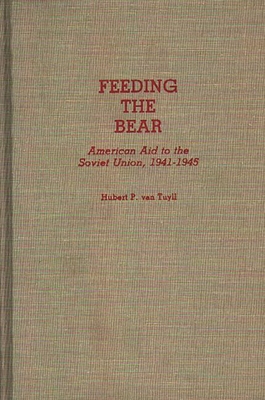
Feeding the Bear: American Aid to the Soviet Union, 1941-1945
Hardcover
Series: Contributions in Military Studies, Book 90
EconomicsGeneral Military HistoryWorld War II
ISBN13: 9780313266881
Publisher: Bloomsbury 3Pl
Published: Sep 25 1989
Pages: 212
Weight: 0.97
Height: 0.68 Width: 6.04 Depth: 9.30
Language: English
When the German army invaded Russia in June 1941, the United States' Lend-Lease system was already in place to aid friendly powers at war and thereby promote the defense of the U.S. Enacted so that the U.S. could lend war material to Britain, the system allowed the transfer of weapons, machinery, agricultural products, and other defense items. Although politically and practically difficult, Lend-Lease was also extended to the Soviets, and in Feeding the Bear, van Tuyll studies the rarely scrutinized subject of the military impact of Lend-Lease on Russian efforts to repel the Nazi invaders. In the post-war period, many histories, memoirs, scholarly studies, and polemics on the Eastern Front by German, American, and Soviet authors have appeared but no comprehensive American official history of the Lend-Lease program was ever published. Van Tuyll uses a wealth of data from many sources including some from the substantial Military Mission files, declassified as recently as 1983, to assess the long-neglected issue of the actual impact of Lend-Lease aid on Soviet victory on the Eastern Front. By synthesizing the many types of technical information, economic data, and statistics, van Tuyll is able to formulate challenging conclusions regarding the program's impact. The difficulty in making this assessment was compounded not only by an almost fifty-year perspective, but also because Soviet information on its military situation, army, or internal economic conditions was scarce and often dismissive of foreign aid. The Germans viewed their failure as due to weather, numbers, Hitler's errors, inadequate intelligence, or lack of gasoline and not to Soviet expertise in the immense offensives of 1943-1945.
Among the ten chapters there are considerations of the complicated Soviet view of Lend-Lease, analyses of the technical aspects, and explorations not only of the overall impact but also of the effect on decisive battles such as Stalingrad and Berlin. The introduction provides a thorough grounding in the background of the Lend-Lease program and surveys other treatments of the subject. The appendix contains over 45 valuable tables that provide data on every aspect of Lend-Lease, including exports by region, value of U.S. shipments to the Soviet Union, deliveries of food, clothing, and medicine, and estimated Soviet production capacity, among others. This is truly a landmark volume that will be consulted and read avidly by students and scholars of European and American History, and World War II in particular, as well as those involved with Military History, Soviet Studies, Soviet Economic History, and U.S.-Soviet Relations.Also from
Tuyll, Hubert P. Van
America's Strategic Future: A Blueprint for National Survival in the New Millennium
Tuyll, Hubert P. Van
Hardcover
Also in
Economics
The Unity of the Capitalist Economy and State: A Systematic-Dialectical Exposition of the Capitalist System
Reuten, Geert
Paperback
The Genius of Israel: The Surprising Resilience of a Divided Nation in a Turbulent World
Singer, Saul
Senor, Dan
Hardcover
Baby Steps Millionaires: How Ordinary People Built Extraordinary Wealth--And How You Can Too
Ramsey, Dave
Hardcover
Origins and Growth of the Global Economy: From the Fifteenth Century Onward
Seavoy, Ronald E.
Hardcover
When McKinsey Comes to Town: The Hidden Influence of the World's Most Powerful Consulting Firm
Bogdanich, Walt
Forsythe, Michael
Paperback
Principles for Dealing with the Changing World Order: Why Nations Succeed and Fail
Dalio, Ray
Hardcover
The Two-Parent Privilege: How Americans Stopped Getting Married and Started Falling Behind
Kearney, Melissa S.
Hardcover
Financial Literacy for All: Disrupting Struggle, Advancing Financial Freedom, and Building a New American Middle Class
Bryant, John Hope
Hardcover
Freakonomics: A Rogue Economist Explores the Hidden Side of Everything
Levitt, Steven D.
Dubner, Stephen J.
Paperback
Random Acts of Medicine: The Hidden Forces That Sway Doctors, Impact Patients, and Shape Our Health
Jena, Anupam B.
Worsham, Christopher
Hardcover
The World Order - Our Secret Rulers: A Study in the Hegemony of Parasitism
Mullins, Eustace Clarence
Paperback
Vulture Capitalism: Corporate Crimes, Backdoor Bailouts, and the Death of Freedom
Blakeley, Grace
Hardcover
American Flannel: How a Band of Entrepreneurs Are Bringing the Art and Business of Making Clothes Back Home
Kurutz, Steven
Hardcover
How to Listen When Markets Speak: Risks, Myths, and Investment Opportunities in a Radically Reshaped Economy
McDonald, Lawrence G.
Hardcover
Predictably Irrational, Revised and Expanded Edition: The Hidden Forces That Shape Our Decisions
Ariely, Dan
Paperback
Power and Progress: Our Thousand-Year Struggle Over Technology and Prosperity
Acemoglu, Daron
Johnson, Simon
Hardcover
Stubborn Attachments: A Vision for a Society of Free, Prosperous, and Responsible Individuals
Cowen, Tyler
Hardcover
The Black Tax: 150 Years of Theft, Exploitation, and Dispossession in America
Kahrl, Andrew W.
Hardcover
The Genesis Book: The Story of the People and Projects That Inspired Bitcoin
Van Wirdum, Aaron
Paperback
AP Microeconomics/Macroeconomics Premium, 2024: 4 Practice Tests + Comprehensive Review + Online Practice
Kacapyr, Elia
Redelsheimer, James
Musgrave, Frank
Paperback
The Big Fail: What the Pandemic Revealed about Who America Protects and Who It Leaves Behind
McLean, Bethany
Nocera, Joe
Hardcover
The End of Reality: How Four Billionaires Are Selling a Fantasy Future of the Metaverse, Mars, and Crypto
Taplin, Jonathan
Hardcover
This Time Is Different: Eight Centuries of Financial Folly
Rogoff, Kenneth S.
Reinhart, Carmen M.
Paperback
From Here to Equality, Second Edition: Reparations for Black Americans in the Twenty-First Century
Mullen, A. Kirsten
Darity, William A.
Paperback
Why Nations Fail: The Origins of Power, Prosperity, and Poverty
Acemoglu, Daron
Robinson, James A.
Paperback
These Are the Plunderers: How Private Equity Runs--And Wrecks--America
Morgenson, Gretchen
Rosner, Joshua
Hardcover
The Hamilton Scheme: An Epic Tale of Money and Power in the American Founding
Hogeland, William
Hardcover
The Internationalization of Capital: Imperialism and Capitalist Development on a World Scale
Berberoglu, Berch
Hardcover
The Lords of Easy Money: How the Federal Reserve Broke the American Economy
Leonard, Christopher
Paperback
Economics in One Lesson: The Shortest and Surest Way to Understand Basic Economics
Hazlitt, Henry
Paperback
Extraordinary Popular Delusions and The Madness of Crowds: All Volumes - Complete and Unabridged
MacKay, Charles
Hardcover
The World of Sugar: How the Sweet Stuff Transformed Our Politics, Health, and Environment Over 2,000 Years
Bosma, Ulbe
Hardcover
Too Big to Fail: The Inside Story of How Wall Street and Washington Fought to Save the Financial System--And Themselves
Sorkin, Andrew Ross
Paperback
Visions of Inequality: From the French Revolution to the End of the Cold War
Milanovic, Branko
Hardcover
The Bankers' New Clothes: What's Wrong with Banking and What to Do about It - New and Expanded Edition
Admati, Anat
Hellwig, Martin
Paperback
When Money Dies: The Nightmare of Deficit Spending, Devaluation, and Hyperinflation in Weimar Germany
Fergusson, Adam
Paperback
The Worldly Philosophers: The Lives, Times, and Ideas of the Great Economic Thinkers
Heilbroner, Robert L.
Paperback
Think Like a Freak: The Authors of Freakonomics Offer to Retrain Your Brain
Dubner, Stephen J.
Levitt, Steven D.
Paperback
How to Become Famous: Lost Einsteins, Forgotten Superstars, and How the Beatles Came to Be
Sunstein, Cass R.
Hardcover
Investing in U.S. Financial History: Understanding the Past to Forecast the Future
Higgins, Mark J.
Hardcover
California Burning: The Fall of Pacific Gas and Electric--And What It Means for America's Power Grid
Blunt, Katherine
Hardcover
Poor Economics: A Radical Rethinking of the Way to Fight Global Poverty
Banerjee, Abhijit V.
Duflo, Esther
Paperback
The Hypomanic Edge: The Link Between (a Little) Craziness and (a Lot Of) Success in America
Gartner, John
Paperback
Default: The Landmark Court Battle over Argentina's $100 Billion Debt Restructuring
Makoff, Gregory
Hardcover
Hbr's 10 Must Reads on Leading Digital Transformation (with Bonus Article How Apple Is Organized for Innovation by Joel M. Podolny and Morten T. Hanse
Porter, Michael E.
McGrath, Rita Gunther
Review, Harvard Business
Paperback
Better, Simpler Strategy: A Value-Based Guide to Exceptional Performance
Oberholzer-Gee, Felix
Hardcover
The Deficit Myth: Modern Monetary Theory and the Birth of the People's Economy
Kelton, Stephanie
Paperback
Economics 101, 2nd Edition: From Consumer Behavior to Competitive Markets--Everything You Need to Know about Economics
Cagan, Michele
Mill, Alfred
Hardcover
Wild Ride: A Short History of the Opening and Closing of the Chinese Economy
Stevenson-Yang, Anne
Paperback
How Adam Smith Can Change Your Life: An Unexpected Guide to Human Nature and Happiness
Roberts, Russ
Paperback
...and Forgive Them Their Debts: Lending, Foreclosure and Redemption from Bronze Age Finance to the Jubilee Year
Hudson, Michael
Hardcover
The Hard Truth about Soft Skills: Workplace Lessons Smart People Wish They'd Learned Sooner
Klaus, Peggy
Paperback
Talking to My Daughter about the Economy: Or, How Capitalism Works--And How It Fails
Varoufakis, Yanis
Paperback
The Myth That Made Us: How False Beliefs about Racism and Meritocracy Broke Our Economy (and How to Fix It)
Fuhrer, Jeff
Hardcover
The Capital Order: How Economists Invented Austerity and Paved the Way to Fascism
Mattei, Clara E.
Hardcover
The Sovereign Individual: Mastering the Transition to the Information Age
Davidson, James Dale
Rees-Mogg, Lord William
Paperback
Why Politicians Lie About Trade: ... and What You Need to Know About It
Grozoubinski, Dmitry
Hardcover
Structural Econometric Modeling in Industrial Organization and Quantitative Marketing: Theory and Applications
Hortaçsu, Ali
Joo, Joonhwi
Hardcover
True Professionalism: The Courage to Care about Your People, Your Clients, and Your Career
Maister, David H.
Paperback
Hbr's 10 Must Reads on Managing Yourself, Vol. 2 (with Bonus Article Be Your Own Best Advocate by Deborah M. Kolb)
Review, Harvard Business
Kolb, Deborah M.
Cross, Rob
Paperback
The Ascent of Money: A Financial History of the World: 10th Anniversary Edition
Ferguson, Niall
Paperback


 Sign-In
Sign-In Cart
Cart